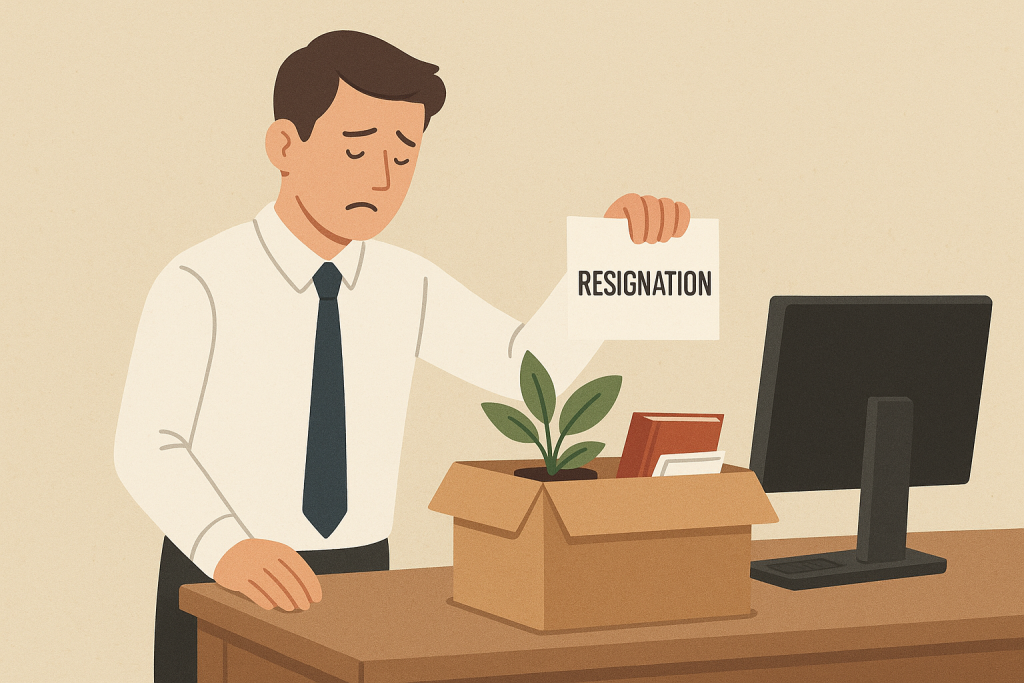What is Employee Turnover?
Employee turnover refers to the rate at which employees leave a company within a specific time frame, typically measured annually. It represents the number of people who have left the organization during a particular period and need to be replaced. This metric can be calculated for the entire organization or broken down by department, team, demographic groups, and other subcategories.
Types of Employee Turnover
Understanding the different types of turnover is crucial for developing targeted retention strategies:
- Voluntary Turnover: When employees choose to leave, such as resigning for a new job or personal reasons
- Involuntary Turnover: When employers decide to part ways with employees due to performance issues or layoffs
- Functional Turnover: The departure of low-performing employees, which can be positive for the company
- Dysfunctional Turnover: The loss of high-performing or valuable employees, which negatively impacts the organization
How to Calculate Employee Turnover Rate
The Recommended Formula for Employee Turnover Calculation
Based on ISO 30414 standards, the most effective approach is:
Turnover Rate = (Number of Employees Who Left ÷ Total Number of Employees at Start of Period) × 100
This formula distinguishes between existing employees and new hires, providing a cleaner calculation that focuses on retention of the original workforce.
Annual vs. Monthly Calculations
Annual Turnover Rate:
- Use the number of employees at the start of the year as the denominator
- Count all departures throughout the year
- Example: If you started with 200 employees and 10 left during the year, your annual turnover rate is 5%
Monthly Turnover Rate:
- Use the same formula but for a monthly period
- Example: Starting February with 300 employees, if 9 left during the month, the monthly turnover rate is 3%
Why This Formula Works Best
This approach avoids three common problems with alternative calculation methods:
- Avoids mixing hires with existing employees – keeping the calculation “pure”
- Maintains a consistent denominator throughout the calculation period
- Provides meaningful results at all levels of data disaggregation
Top 10 Drivers of Employee Turnover
Research involving over 60,000 employees has identified the key predictors of why people leave their jobs:
1. Stress
Work-related stress is a primary driver of turnover, caused by:
- Role clarity issues: Unclear responsibilities create uncertainty
- Role conflict: Contradictory job expectations
- Role overload: Insufficient resources to manage workload
- Work-life balance: Poor quality of life outside work
2. Demographic Factors
Certain demographic variables strongly predict turnover intentions:
- Age: Younger employees leave more frequently than older ones
- Family status: People with children are less likely to switch jobs
- Marital status: Married individuals show lower turnover rates
- Tenure: The most significant predictor – employees are most likely to leave in years 4-5
3. Leadership Quality
The saying “people leave their bosses, not their jobs” is research-backed:
- Supervisory satisfaction: Happy relationships with managers increase retention
- Leader-member exchange: Two-way relationships where managers recognize individual contributions
- Managers determine 70% of team engagement variance
4. Job Satisfaction
Key components include:
- Overall job satisfaction: General contentment with the role
- Met expectations: Whether the job matches pre-employment expectations
- Job involvement: Level of engagement with the work itself
5. Work Satisfaction
Focuses specifically on the tasks and responsibilities:
- How fulfilling the actual work is
- Whether employees feel motivated by their daily activities
- Alignment between personal interests and job requirements
6. Job Content
The nature of the work itself affects employee retention:
- Routinization: Excessive repetition leads to higher turnover
- Promotional opportunities: Clear career advancement paths improve retention
- Communication style: Goal-oriented, instrumental communication helps define expectations
7. External Environment
Comparison with outside opportunities influences decisions:
- Alternative job opportunities: Fewer alternatives reduce likelihood of leaving
- Competitive landscape: How current role compares to available options
8. Co-worker Relationships
Team dynamics significantly impact retention:
- Workgroup cohesion: Strong colleague relationships reduce turnover
- Co-worker satisfaction: Positive workplace relationships increase retention
9. Compensation
It’s not just about the amount, but perception:
- Pay satisfaction: How employees feel about their compensation relative to others
- Distributive justice: Perception that compensation is fair and equitable
- Market benchmarking becomes crucial for retention
10. Behavioral Indicators
Warning signs that predict departures:
- Lateness: Consistent tardiness may indicate demotivation
- Absenteeism: Higher absence rates correlate with departure intentions
- Performance patterns: Both low and exceptionally high performance can predict turnover
The Cost and Impact of High Turnover
Financial Costs
- Replacement costs typically range from one to two times the departing employee’s annual salary
- According to the Work Institute, voluntary turnover costs U.S. companies approximately $900 billion annually
- Additional costs include knowledge loss, productivity drops, and decreased team morale
Operational Impact
High turnover creates cascading effects:
- Productivity decline: Vacant positions and learning curves for new hires
- Increased workload: Remaining employees must cover additional responsibilities
- Reduced morale: Constant departures can demotivate staying employees
- Knowledge loss: Institutional knowledge walks out the door
- Recruitment strain: Continuous hiring and training cycles
Seven Strategic Approaches to Reduce Turnover
1. Understand Your Specific Turnover Drivers
- Conduct comprehensive analysis of why employees leave your organization
- Use exit interviews, stay interviews, and employee surveys
- Identify patterns by department, role, tenure, and demographics
2. Implement Detailed Turnover Tracking
- Monitor turnover rates across different organizational segments
- Track trends over time to identify emerging issues
- Use data to prioritize retention efforts where they’re needed most
3. Conduct Strategic Stay Interviews
Stay interviews serve dual purposes:
- Understand why valuable employees choose to remain
- Proactively identify and address potential departure triggers
- Demonstrate organizational commitment to employee retention
4. Optimize Exit Interview Processes
- Gather honest feedback from departing employees
- Identify systemic issues and improvement opportunities
- Use insights to develop targeted retention strategies
5. Focus on Management Fundamentals
Create a solid foundation for employee engagement:
- Fair compensation and safe working conditions
- Well-resourced managers with proper support tools
- Purpose-driven work that enables valuable contributions
- Meaningful recognition with clear growth opportunities
- Strong team connections where employees feel heard
6. Prioritize Communication and Transparency
- Set clear expectations from recruitment through employment
- Provide regular feedback on performance and career prospects
- Communicate growth opportunities and development possibilities
- Ensure employees understand their role in organizational success
7. Target Retention Efforts Strategically
- Use turnover data to focus efforts where they’ll have the most impact
- Address high-priority areas first (e.g., new hire turnover, critical departments)
- Develop role-specific retention strategies based on identified patterns
The Interaction Effect: Why Multiple Employee Turnover Factors Matter
Employee turnover predictors don’t operate in isolation, they interact with each other in complex ways that significantly impact how to reduce employee turnover. Understanding these interactions is crucial for developing effective retention strategies that address the real complexity of employee decision-making.

Age and Life Stage Interactions
The relationship between age and other demographic factors creates nuanced employee turnover patterns that require different retention approaches:
Early Career (20s-30s):
- Age + Marital Status: Single young employees show highest mobility, actively seeking career advancement and new experiences. They’re willing to take risks but also quick to leave if growth stagnates.
- Age + Compensation: Younger workers may initially accept lower pay for learning opportunities, but become significant turnover risks when advancement or salary progression stalls.
- Age + Work-Life Balance: Pre-family employees often prioritize career building over work-life balance, leading to higher stress tolerance but also burnout risks.
Mid-Career (30s-40s):
- Age + Family Responsibilities: Married employees with children show dramatically lower employee turnover rates due to financial obligations and stability needs, but become highly sensitive to work-life balance issues.
- Age + Geographic Mobility: Family ties severely reduce willingness to relocate, making local career advancement opportunities absolutely critical for retention.
- Age + Risk Tolerance: Greater responsibilities make job changes riskier, creating “golden handcuffs,” but also increase demands for fair compensation and recognition.
Late Career (50s+):
- Age + Tenure: Long-term employees become increasingly unlikely to leave voluntarily, but may opt for early retirement if workplace satisfaction declines.
- Age + Benefits: Health insurance, retirement benefits, and job security become primary retention factors, often outweighing salary considerations.
- Age + Learning Agility: May resist technological changes or new processes, requiring different change management and training approaches.
Gender and Workload Dynamics
Gender roles and expectations create distinct employee turnover interaction patterns that organizations must navigate carefully:
Traditional Gender Role Impacts:
- Women + Career Planning: Career interruptions for childbearing create predictable turnover spikes, but comprehensive family support and flexible work arrangements can significantly improve retention.
- Men + Financial Pressure: Traditional breadwinner expectations may keep men in unsatisfactory jobs longer than women, but also make them prime targets for competitor recruitment with higher salaries.
- Dual-Career Couples: Both partners’ career trajectories create complex decision matrices where one person’s job change can trigger the other’s departure.
Workload and Responsibility Interactions:
- Gender + Overtime Expectations: Different tolerance levels and family obligations significantly affect willingness to work extended hours, with implications for role assignments and advancement opportunities.
- Gender + Travel Requirements: Family responsibilities may make travel-heavy roles unsustainable for some employees, requiring creative solutions or role modifications.
- Gender + Leadership Opportunities: Perceived or actual barriers to advancement interact with gender to influence long-term career planning and departure decisions.
Tenure and Performance Intersections
The relationship between employment length and performance creates some of the most surprising employee turnover patterns:
High Performers + Short Tenure (0-2 years):
- Risk Factor: May leave quickly if rapid growth expectations aren’t met or if they feel unchallenged
- Retention Strategy: Accelerated development programs, mentorship, and clear advancement timelines
- Warning Signs: Exceptional early performance followed by visible frustration or plateau
High Performers + Medium Tenure (3-7 years):
- Risk Factor: Peak departure risk as they seek senior roles that may not be available internally
- Retention Strategy: Leadership development, succession planning inclusion, and expanded responsibilities
- Warning Signs: Increased external networking, skill diversification, or requests for new challenges
Average Performers + Long Tenure (8+ years):
- Risk Factor: Complacency may mask hidden dissatisfaction or feeling undervalued
- Retention Strategy: Re-engagement through new challenges, role modifications, or recognition programs
- Warning Signs: Gradual performance decline, resistance to change, or disengagement from team activities
Low Performers + Any Tenure:
- Risk Factor: May leave before performance improvement efforts can take effect, or after receiving negative feedback
- Retention Strategy: Determine if performance issues are correctable through training, role adjustment, or support
- Warning Signs: Defensive behaviors, disengagement from feedback, or sudden performance drops
Compensation and External Market Interactions
Employee turnover becomes significantly more complex when internal compensation satisfaction intersects with external market conditions:
High-Demand Skills + Market Competition:
- Internal Satisfaction + External Opportunities: Even internally satisfied employees may leave when external offers significantly exceed current compensation
- Skill Scarcity + Market Premium: Employees with rare skills command market premiums that can quickly make internal pay seem inadequate
- Industry Growth + Talent Wars: Rapidly growing industries create bidding wars that can destabilize even well-compensated teams
Economic Conditions + Personal Financial Circumstances:
- Job Security + Economic Uncertainty: Employees may stay in unsatisfactory roles during recessions but become significant flight risks during economic recovery
- Personal Debt + Risk Aversion: High personal financial obligations reduce willingness to change jobs regardless of workplace dissatisfaction
- Life Stage + Financial Goals: Different career phases create varying sensitivity to compensation, benefits, and job security
Management Quality and Team Dynamics Synergies
Leadership effectiveness doesn’t exist in isolation—it interacts powerfully with team composition and organizational culture:
Manager Quality + Team Environment:
- Excellent Manager + Dysfunctional Team: Even outstanding individual management may not overcome toxic peer relationships or team dysfunction
- Poor Manager + Strong Team Culture: Peer support and team solidarity can temporarily buffer against inadequate management, but this protection has limits
- Management Turnover + Team Stability: Frequent management changes compound employee turnover risks by creating uncertainty and disrupting established relationships
Communication Effectiveness + Organizational Context:
- Transparent Communication + Open Culture: Reinforces trust and reduces uncertainty-driven departures throughout the organization
- Poor Communication + Secretive Environment: Creates compounding distrust that affects multiple employee turnover drivers simultaneously
- Inconsistent Messaging + Change Periods: Mixed messages during organizational transitions amplify departure risks across all employee segments
Stress and Support System Interactions
Workplace stress doesn’t affect all employees equally—personal and organizational support systems create complex interaction patterns:
Individual Resilience + Organizational Demands:
- High Stress + Strong Personal Support: Family and social networks can effectively buffer significant workplace pressures
- Moderate Stress + Limited Support Systems: May create higher employee turnover risk than high stress with strong support networks
- Role Ambiguity + Personality Types: Detail-oriented employees suffer disproportionately from unclear expectations and responsibilities
Organizational Support + Individual Utilization:
Policy Flexibility + Life Circumstances: Flexible work arrangements become crucial during major life transitions, family emergencies, or health challenges
Comprehensive Programs + Help-Seeking Comfort: Employees comfortable accessing support benefit significantly more from EAP and wellness programs
Wellness Initiatives + Personal Health Priorities: Health-conscious employees respond more positively to wellness-based retention efforts
Best Practices for Implementation
Start with Data
Effective employee turnover management begins with establishing a clear baseline understanding of your organization’s current situation. Calculate your current employee turnover rate using the recommended ISO 30414-compliant formula to ensure accuracy and consistency in your measurements. This foundational step provides the concrete data needed to make informed decisions about retention investments and strategies.
Once you have your baseline measurements, benchmark these rates against industry standards to understand whether your employee turnover levels represent a competitive advantage, a significant concern, or fall within normal ranges for your sector. Industry benchmarking reveals whether your retention challenges are unique organizational issues or broader market dynamics affecting all employers in your field. This context is crucial for setting realistic improvement goals and expectations.
With baseline data and industry context established, conduct a thorough analysis to identify your organization’s specific problem areas. Examine employee turnover patterns across different departments, job levels, tenure groups, and demographic segments to pinpoint where retention efforts will have the greatest impact. This granular analysis often reveals surprising patterns—such as higher turnover in seemingly desirable departments or unexpected retention challenges in specific employee populations—that inform more targeted and effective interventions.
Develop Targeted Solutions
Armed with data-driven insights about your specific employee turnover challenges, prioritize addressing the most critical turnover drivers first. Focus your initial efforts on the factors that affect the largest number of employees or the highest-value talent segments. This strategic approach ensures that limited resources generate maximum impact and creates early wins that build momentum for broader retention initiatives.
Recognize that different departments, roles, and employee groups face distinct retention challenges that require customized approaches. Create department-specific retention strategies that address the unique stressors, career paths, and motivational factors relevant to each area of your organization. For example, technical teams might need different career development opportunities than sales teams, while customer service departments might require different stress management support than accounting departments. These tailored strategies demonstrate understanding of employees’ specific work experiences and challenges.
Implementation without measurement leads to wasted effort and missed opportunities. Establish systems to monitor the effectiveness of your retention interventions over time, tracking both employee turnover rate changes and leading indicators like employee satisfaction scores, engagement levels, and stay interview feedback. Regular monitoring allows you to identify which strategies are working, which need adjustment, and where additional interventions might be necessary. This continuous improvement approach ensures that your retention efforts evolve and improve rather than becoming static programs.
Create a Culture of Retention
Sustainable employee turnover reduction requires transforming retention from an HR initiative into an organization-wide commitment and competency. Make retention a shared responsibility across all management levels by incorporating employee retention metrics into manager performance evaluations, providing retention-focused training for supervisors, and creating accountability systems that reward effective people management. When managers at every level understand that keeping good employees is part of their job success, retention becomes embedded in daily management practices rather than an afterthought.
Consistent communication about the importance and impact of employee retention helps maintain organizational focus on this critical business objective. Regularly share retention successes, challenges, and goals with employees at all levels to demonstrate leadership commitment and keep retention top-of-mind throughout the organization. This ongoing communication helps employees understand that their retention and satisfaction matter to organizational success, which itself can improve retention by making employees feel valued and important.
Recognition and celebration of retention successes create positive reinforcement cycles that encourage continued focus on keeping good employees. Celebrate managers who successfully retain high-performing team members, departments that improve their retention rates, and innovative solutions that address specific turnover challenges. Share success stories and lessons learned across the organization to spread effective practices and inspire continued improvement efforts. This celebration approach transforms retention from a defensive challenge into a positive organizational capability that people take pride in developing and maintaining.
Conclusion
Employee turnover is a complex issue that requires a multifaceted approach. While 42% of turnover is preventable, organizations must first understand how to accurately measure it, identify their specific drivers, and implement targeted strategies. Success comes from combining accurate measurement, thorough analysis of causes, and strategic implementation of retention initiatives.
The key is recognizing that retention isn’t just an HR responsibility—it requires organization-wide commitment to creating an environment where employees want to stay, grow, and contribute to long-term success. By focusing on the fundamentals of good management, fair compensation, clear communication, and meaningful work, organizations can significantly reduce unwanted turnover and build a more stable, engaged workforce.


